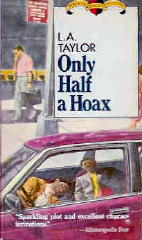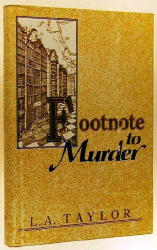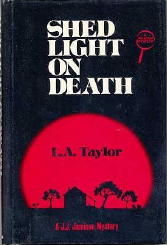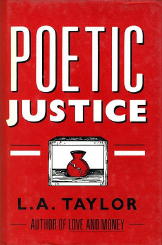Fri 15 Aug 2008
Archived Mystery.File Review: L. A. TAYLOR – Only Half a Hoax.
Posted by Steve under Authors , Bibliographies, Lists & Checklists , Crime Fiction IV , Reviews1 Comment
L. A. TAYLOR – Only Half a Hoax.
Walker; paperback reprint, 1986; hardcover edition, 1983.
First of all, let me say it is about time [1987] Walker started reprinting some of their American detective fiction in paperback. In the past four or five years Walker seems to have come from nowhere to become of one of the leading publishers of hardcover mysteries, most of which seems to have been ignored by other paperback companies.
(They have been reprinting their British mystery fiction in paper for several years now, but for the most part, I find myself too easily bored with the general run of “thriller” this entails.)

I also have to say that I’m glad they chose to include the Taylor books in their first batch of releases. (His/her second book, Deadly Objectives, is also now out.) I have to confess that I had the chance to pick this one earlier in hardcover, and I turned up my nose at the chance. I mean, after all, a detective whose hobby is chasing down reports of UFO’s in the Minneapolis area?
No offense intended to Minneapolitans. I’m sure it must be a terrific place to live, in spite of the comments of J. J. Jamison (the aforementioned detective) sometimes to the contrary. But flying saucers and detective fiction seems such an incongruous combination, I couldn’t imagine myself reading such balderdash, much less enjoying it.
But enjoy this book, I did. Even though J. J. (his full-time job a computer engineer) is pretty much a naive sort of neophyte at the detective business, the case he enters into is breezily told, and is easily recognized as a throwback to the wacky cases of homicide that were exceedingly popular back in the 1940s.
And reflecting back on it now, the plot doesn’t really make a lot of sense. If you’re planning a murder, why should your first impulse be to set up an elaborate fake UFO in order to draw attention away from the act you’re about to do?
When J. J. investigates and finds the body, he’s first suspected of complicity, then becomes the killer’s target. Chronologically: (1) his brakes are tampered with, (2) he is nearly run down while bike riding, (3) his house is set on fire, and (4) he is dumped in the tiger cage of the Minnesota Zoo. Maybe I missed one.
The point of all this is to keep the reader’s mind off the fact that there really are very few suspects, and the clues are a little too obvious to withstand direct attention. It takes the last ten pages to wrap everything up is well, which is far too long for a mystery properly told. Even in the 40s, though it took time to make the illogical satisfactorily plausible.
In spite of my earlier comments, Taylor does well at this sort of thing, and throws in a little bit of surprise to boot.
[UPDATE] 08-15-08. Several things are clear from this review, reading through it this evening for the first time myself in over eleven years. First of all, and most importantly, it is clear that I did not know whether or not L. A. Taylor was male or female. It is much easier to answer questions like this now, what with the Internet, and the handy assist of Al Hubin’s Revised Crime Fiction IV:
TAYLOR, L. A. [Laurie Aylama Taylor Sparer]. 1939-1996. Series character: JJ = J. J. Jamison
Footnote to Murder. Walker 1983. JJ

Only Half a Hoax. Walker 1983. JJ
Deadly Objectives. Walker 1984. JJ
Shed Light on Death. Walker 1985. JJ

Love of Money. Walker. 1986
Poetic Justice. Walker. 1988

A Murder Waiting to Happen. Walker 1989. JJ [set at a Minnesota SF convention]
Besides the mysteries listed above, she also wrote Blossom of Erda, a science fiction novel; Cat’s Paw, a fantasy; and (possibly) Women’s Work a collection of both SF and fantasy. (I’ve not yet found confirmation that the latter was ever published.)
It therefore now comes as no great surprise to find the SFnal elements that are so obviously present in Only Half a Hoax. As you’ve read, I found them semi- objectionable in 1986. I’d like to think I’d find them less so now.
After her death Ms. Taylor’s husband had her final novel published: The Fathergod Experiment, described online as “a quirky, complex, interesting tale that combines court intrigue with mysteries both scientific and criminal, and a thoroughly satisfying story of an orphan rising from obscurity and oppression.”
I’ve forwarded a more complete description to Al. It appears that the books ought to be included in CFIV, at least marginally. (Added later: He agrees. The book will appear in Part 29 of the online Addenda.)
Also of note in the review, at least to me, was my mammoth snobbish putdown of British thriller fiction. You can blame my younger self for that, but not this present fellow who I am now.
December 1st, 2008 at 9:06 pm
[…] rights, in a world that was absolutely perfect, this would have followed my review of L.A.Taylor’s Only Half a Hoax, as here is another book taking place in the twin cities […]